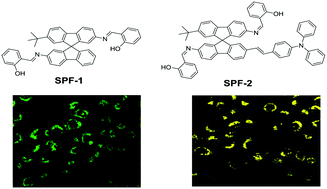Two spirobifluorene-based fluorescent probes with aggregation-induced emission properties: synthesis and application in the detection of Zn2+ and cell imaging†
Abstract
In this work, two spirobifluorene-based probes, namely SPF-1 and SPF-2, were designed and synthesized. They exhibited high selectivity and sensitivity toward Zn2+ with enhanced emissions, which could be attributed to the formation of an L–Zn complex. The detection limit of SPF-2 is 63 nM for Zn2+ and this is significantly lower than most previous reports. SPF-1 was successfully used for intracellular Zn2+ imaging. In addition, SPF-2 possesses two-photon absorption properties and has been applied in two-photon fluorescence cell imaging. This study is the first time that a spirobifluorene-based probe with aggregation-induced emission enhancement (AIEE) properties has been reported. We hope that this molecular design triggers further interest in using spiro-configured compounds in AIEE-based bioprobes for further applications.

- This article is part of the themed collection: Editor’s Choice: Spiro compounds for electronics


 Please wait while we load your content...
Please wait while we load your content...